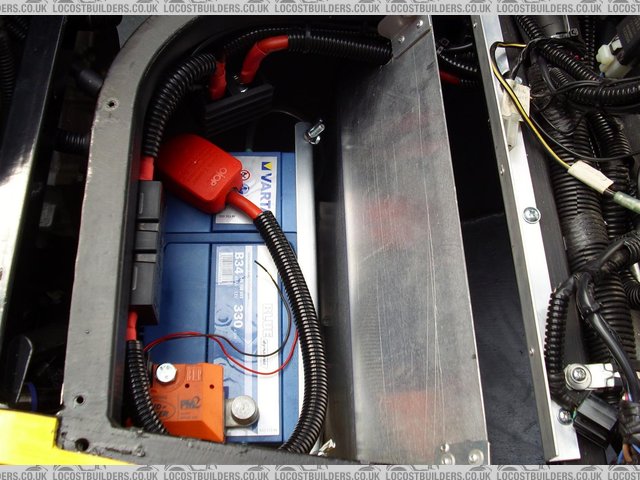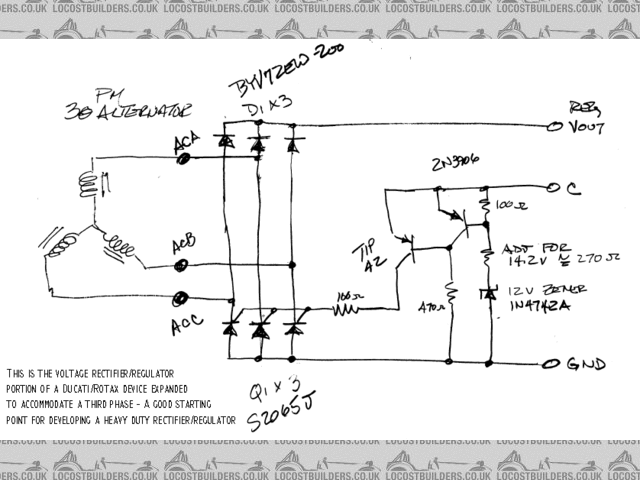Jamesc
|
| posted on 13/5/15 at 12:11 PM |

|
|
Two batteries..
Hi,
I'm planning on installing a second battery for the reverse motor as I have a small main battery.. Also do not want it to charge off the
alternator - I'll trickle charge at home.
I have planned that the earth will be the chassis such as normal, but I am wondering if this will have any affect on the other battery/electrics
generally and during operation?
Thanks,
James
|
|
|
|
|
r1_pete
|
| posted on 13/5/15 at 12:18 PM |

|
|
It shouldn't have any effect, as unless you are actually reversing it will not have a complete circuit, are you running reverse lights off this
battery too or using a relay into the main battery?
Have you thought about the split charging systems caravaners use, I think it charges the second battery when the main battery is fully charged, so
only uses the alternator when not needed for the primary...
|
|
|
Jamesc
|
| posted on 13/5/15 at 12:32 PM |

|
|
The reverse lights are off the main battery. I thought it best to run a separate battery to reduce the load on the alternator as it's a bec.
(Also easier for it to fall off after IVA if that were to happen).
The split charge system is something I have thought about, but kind of dismissed already.. no real reason why though!
I didn't think it would cause a problem as it isn't making a full circuit, but I'm no electrical expert! So the power from the
battery to the motor would return to the same battery as that's making a full circuit. Is that the correct train of thought?!
Thanks for the reply.
|
|
|
40inches
|
| posted on 13/5/15 at 02:30 PM |

|
|
I originally did this with a split charge relay, but found the bike alternator charged the large battery fine, so just used the one battery.
 
Description
|
|
|
britishtrident
|
| posted on 13/5/15 at 03:23 PM |

|
|
Shouldn't make any diffetence to the alternator as on a bike alternator output isn't controlled the excess output goes to ground via the
zenner anyway.
[I] “ What use our work, Bennet, if we cannot care for those we love? .”
― From BBC TV/Amazon's Ripper Street.
[/I]
|
|
|
Jamesc
|
| posted on 13/5/15 at 03:33 PM |

|
|
quote:
Originally posted by britishtrident
Shouldn't make any diffetence to the alternator as on a bike alternator output isn't controlled the excess output goes to ground via the
zenner anyway.
That's interesting - So they output the same power all the time? Does all that power get rectified?
Anyway, the idea behind the dual battery is that the entire reverse system can be removed easily after IVA if required.
|
|
|
02GF74
|
| posted on 13/5/15 at 08:00 PM |

|
|
Why would you not want a reverse?
Why make it more complicated?
Larger battery charged off alternator.
Sod law is such that the one time you need reverse is the day after you forgot to charge it.
|
|
|
BenB
|
| posted on 13/5/15 at 08:45 PM |

|
|
I'd be tempted to charge it. Then when you're reversing you'll have engine power and alternator volts plus battery volts. A
battery voltage under high load will quickly sag.
|
|
|
Jamesc
|
| posted on 13/5/15 at 09:21 PM |

|
|
The primary use will be track days, but I'll need to drive it there, hence the ease of removal and small main battery.
I'll take all of your advice and have a re think though.
Do bike engines have enough charging power when reversing to keep running?
|
|
|
40inches
|
| posted on 14/5/15 at 07:27 AM |

|
|
quote:
Originally posted by Jamesc
Do bike engines have enough charging power when reversing to keep running?
If you are using a small car battery or a large bike battery, Yes. If using an average sizes bike battery, probably not.
|
|
|
Adam
|
| posted on 14/5/15 at 12:46 PM |

|
|
I have this set up on my Triabusa. The reverse is off a totally separate circuit. I actually used a Golf buggy battery, large amps  works a
treat. I just trickle charge it when the car is not in use. works a
treat. I just trickle charge it when the car is not in use.
Cheers
Adam
|
|
|
Jamesc
|
| posted on 14/5/15 at 01:27 PM |

|
|
quote:
Originally posted by Adam
I have this set up on my Triabusa. The reverse is off a totally separate circuit. I actually used a Golf buggy battery, large amps  works a
treat. I just trickle charge it when the car is not in use. works a
treat. I just trickle charge it when the car is not in use.
Cheers
Adam
What was your reason for installing the buggy battery? Is the negative earthed through the chassis?
I think the battery I have is 440A peak and about 45Ah - I assume on the large size for the bike alternator.
|
|
|
Adam
|
| posted on 14/5/15 at 03:13 PM |

|
|
I have a friend who was running a car battering to run it. the amount of times he had to re charge his battery was crazy, so did some research and
came up with the golf buggy battery. Works a treat. I have mine earthed to the chassis. Theres no direct connection into the car/bike loom..
Totally separate circuit. Never failed me yet and been using quite a lot of late.
Cheers
Adam

[Edited on 14/5/15 by Adam]
|
|
|
MikeRJ
|
| posted on 14/5/15 at 06:25 PM |

|
|
quote:
Originally posted by Jamesc
quote:
Originally posted by britishtrident
Shouldn't make any diffetence to the alternator as on a bike alternator output isn't controlled the excess output goes to ground via the
zenner anyway.
That's interesting - So they output the same power all the time? Does all that power get rectified?
The 3 phase rectifier uses either SCRs (silicon controlled rectifiers) or MOSFET transistors on the lower half of the bridge, and the regulator
switches the SCRs/MOSFETs on when the output voltage reaches the regulated limit. This effectively shorts the three phase outputs of the generator
together. Most of the energy is dumped in the (oil cooled) generator windings and some in the regulator/rectifier itself.
Since it is a shunt regulator, the load on the generator is pretty much constant, i.e. you aren't putting any more load on the generator when
you switch ancillaries on.
 
Three Phase Reg/Rect
|
|
|
02GF74
|
| posted on 14/5/15 at 08:11 PM |

|
|
For track usage, so youll remove it when you get there?
What happens if you spun off and need to use reverse, i cannot imagine the track owmers/event organisers being keen on having drivers on the track so
there can push their cars? Youll be sitting there waiting for marshalls to put you in track meanwhile your allocated track time is ticking away.
Still think that having a small but high capacity battery, not lead acid, lipo maybe, is a simpler and more reliable may even work out to be lighter.
|
|
|













